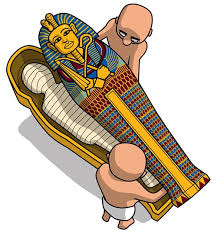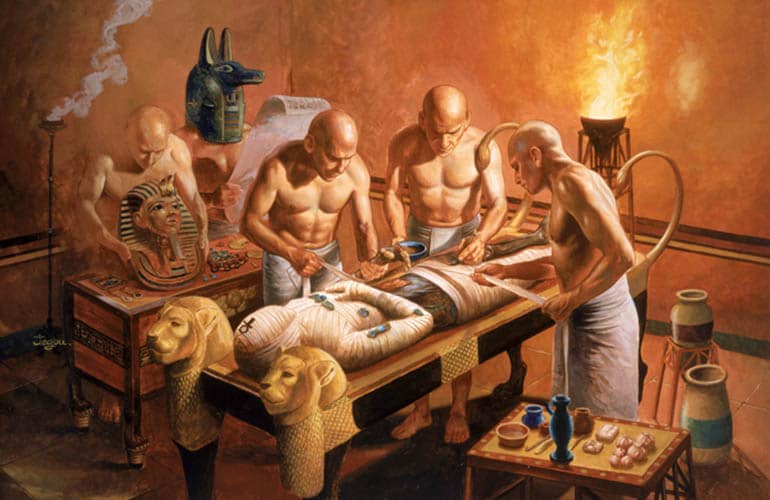

Here we take a look at the chemicals used in the process, and how modern chemistry can help us identify them. However, there’s a little more behind the traditional embalming process used in Ancient Egypt, as well as a surprising amount of chemistry.
#Drying out and covering body with natron ancient egypt how to
Instructions on how to make your own Mummy.Mummies are, perhaps, the easiest go-to costume for Halloween: grab some bandages, drape yourself in them, and job done. In order to go to the underworld, you had to be mummified.

Egyptians paid vast amounts of money to have their bodies properly preserved - trained undertakers treated the body with chemicals and wrapped it in tight bandages to keep it in shape.Ĭlick on different parts of the Mummy you will see, to view interesting facts and information about the mummification process. They would need all the things they had used when they were alive, so their families would put those things in their graves. The Egyptians believed that when they died they would make a journey to another world where they would lead a new life. Why did the ancient Egyptians mummify their cats, dogs, crocodiles, birds, even eels? Follow this tour to find out.ĭeath and the Afterlife by Mark Telford, Aged 8yrs See the pictures of the materials and tools used in mummification.Īnimal Mummies - Compass Site ( The British Museum ) You wouldn't want to become an Egyptian Mummy.

Learn to make a mummy and prepare the pharaoh for his tomb.s The tombs were designed to protect the buried Pharaoh's body and his belongings. The Egyptians believed that if the pharaoh's body could be mummified after death the pharaoh would live forever. Why did the Ancient Egyptians build pyramids? The pyramids are the stone tombs of Egypt's kings - the Pharaohs. They were built on the desert edge, west of the ancient capital of Memphis. In the Old and Middle Kingdoms (2628-1638 BC), Egyptian kings were buried in pyramids. The poor Egyptians were buried in the sand. Where were Egyptians who were poor buried? The objects included furniture, games and even food was placed in the tombs for the long After Life journey!Ĭanopic Jars were used by ancient Egyptians to hold mummified remains. What objects did they put in Egyptian Tombs?Īncient Egyptians were buried with their belongings and the tomb walls were painted with scenes from the dead persons life. His job was to prepare the bodies of the dead to be received by Osiris. He had a human body and the head of a jackal. The Egyptians thought the heart was the centre of intelligence and emotion.Īnubis was the god of mummification. Why did they leave the heart in the body? It was used by the ancient egyptians to dry out the bodies. Natron is a natural salt, composed of sodium carbonate and sodium bicarbonate with traces of sodium chloride and sodium sulfate. The mummy was now ready for its journey to the afterlife. The body was placed in a stone coffin called a sarcophagus. The body was wrapped in strands of linen and covered in a sheet called a shroud.ħ. After 40 - 50 days the stuffing was removed and replaced with linen or sawdust.Ħ. This substance absorbed all the moisture from the body.ĥ. The body was dried by covering it with a substance called natron*. The priest in charge would wear the mask of a jackal representing the god Anubis.Ģ. It took a very long time, from start to finish, it took about 70 days to embalm a body. What was the name of the process the Egyptians used to preserve their bodies? Egyptians who were poor were buried in the sand whilst the rich ones were buried in a tomb. Egyptians paid vast amounts of money to have their bodies properly preserved. The Egyptians believed that when they died, they would make a journey to another world where they would lead a new life. They believed that they had to preserve their bodies so they could use them in the afterlife.

The Egyptians believed in life after death. They were any Egyptian who could afford to pay for the expensive process of preserving their bodies for the afterlife. Mummification was a complicated and lengthy process which lasted up to 70 days.Ī mummy is the body of a person (or an animal) that has been preserved after death. A method of artificial preservation, called mummification was developed by the ancient Egyptians. It was very important to ancient Egyptian religious beliefs that the human body was preserved.


 0 kommentar(er)
0 kommentar(er)
